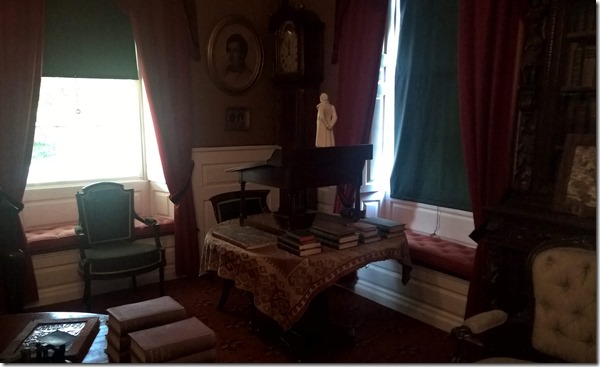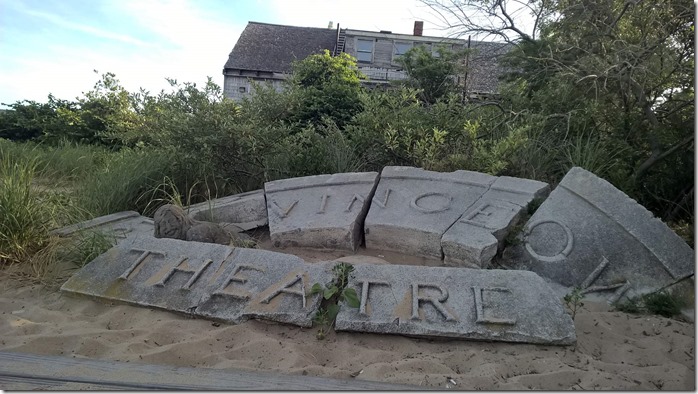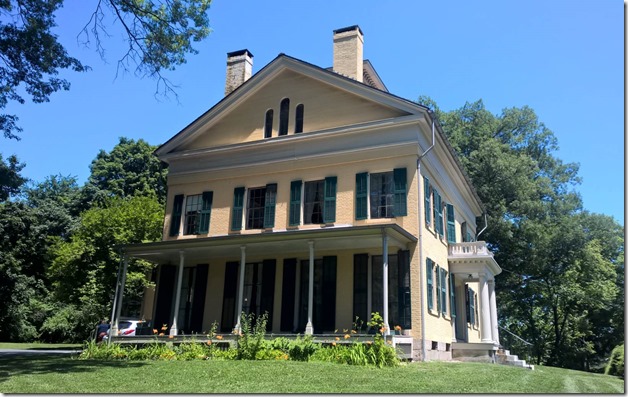You may have noticed fewer new pieces posted here over the past month. There are a variety of un-interesting reasons for that, but one cause is worth a post, even if it’s not representative of what you usually find here. Think of it as a “make up post” for the missing activity this July.
This month I traveled to Massachusetts with my family and some friends. My concerns with this project have lead me to cast some recent trips as literary pilgrimages. Since our expedition was a mixed-age group of five, that wasn’t all that we did of course, and many of my memories of this trip are more about fellowship with the rest of the travelers, and not just with the connections I sought with long-dead writers. But let me focus on the literary highlights of this trip today.
Boston/Cambridge
We stayed at the Parker House hotel, which was well situated and has a long history connected to the culture of the city. Operating since before the Civil War, it was the meeting site for the Saturday Club, where the region’s considerable 19th Century culture elite met. And for desert, the Boston Cream Pie was developed there too! The current hotel building doesn’t go back to those days, it dates to the 1920s, but since two of our party were 21st Century people, there was plenty of historic charm along with a good night’s sleep to be had there. Alas all that masonry or other infrastructure issues meant the WiFi service was at 1920s level too, so my blog activity was minimal during the trip.
My companion book for this trip was Matthew Pearl’s The Dante Club. I was delighted to find our hotel and the still-standing (though it’s a Chipotle now) Ticknor and Fields publisher and bookstore building just down the street were locations used in the book. The book is ostensibly a mystery novel, but what it actually does is attempt to recreate post-Civil War Boston and Cambridge as it would have been experienced by the prominent local poets of the time. Particularly in the opening chapters this requires the reader to struggle with their 21st Century sensibilities. Pearl uses excerpts from these authors’ books and letters repurposed as spoken dialog to convey that time’s sensibilities, and I found that slow going. Not only am I a 20th Century Modern in my own literary sensibilities, but I also believe that their ordinary conversational speech would not be the same as those fountain pen strokes. In the course of the book, Pearl violates every one of Elmore Leonard’s rules for good writing—though they were only the rules that worked for Leonard, and even he admits exceptions. The plot too is somewhat creaky, though that’s a common fault for mysteries.
Am I not tempting you to read this book? On the contrary, I eventually found it captivating. As we moved about Boston and Cambridge, and as I read more of the authors it references, the level of historical research Pearl put into this became apparent. I now want to try his current book, a sequel, that is apparently set among the Pre-Raphaelites, to see if his magic works when you aren’t walking around in the characters’ footsteps.
Henry Wadsworth Longfellow’s oh so modern standing desk. The small statue on top? Goethe.
Pearl’s book is largely responsible for our visit to Longfellow’s house in Cambridge, and for me taking the time to check out Longfellow’s now unfashionable work. We walked through the room there where Longfellow’s beloved wife was sealing envelopes containing locks of their children’s hair with help from her daughters one summer’s day when the sealing wax melting candle caught her dress on fire. The room where Longfellow rushed in and tried to smother the fire engulfing his wife with a rug and his body. He suffered burns from that fire, painful and life-scaring (that bushy beard wasn’t just a fashionable affectation), but not fatal as were the ones that took his wife’s life by the next day. The room he rushed from? His writing room, with it’s nowadays in-fashion standing desk (a tactic he shared with Hemmingway), a room decorated with carved Goethe, Dante, and Shakespeare, all looking at him, asking him to “Let us, then, be up and doing.” I now read his work and think of what it does not say in what it does say.
Provincetown
When told we planned to go to Provincetown, someone asked my wife “You know how wild it is don’t you?” Well, yes, it’s extraordinarily crowded on a summer day with people from other New England places looking for a change of scene, and gayer than a Pride parade. The main street is full of establishments that cater to the not-quite-needs of no-purpose-but-the-change visitors, and the milling throngs are deep in thought of how good a time they are having verses their expectations.
We got off the ferry and had a tasty early lunch of hip-casual fusion food in a place with a patio covered in sand that had a view of the beach, and past that to the ocean that which can’t be bothered with time, which is always visiting, and therefore isn’t a visitor.
We then picked up rental bicycles, and after reminding one brave member of our expedition that riding a bicycle is, well, like riding a bicycle, we took off on a five-mile jaunt up to the highest point on this area of the cape. There’s a widow’s-walk porch atop the visitor’s center at this high point, full of fresh breezes and a view of that ocean again, beside which lie grassy sand dunes that meet that wind with ardent curvatures. I’ve read that the higher water levels and fiercer storms of our human-heated climate have damaged these features, but to us, visitors, it still read as wild and timeless.
After a good long meditation with wind and outlooks, I was reminded of my reason for going to Provincetown, and we set back on bicycles for the town again too look for the house once owned by Susan Glaspell and her husband George Cram Cook. My paternal grandparents are from the same south-eastern Iowa location that Cook and Glaspell grew up in, and though as far as I know they had no direct participation in The Davenport Group, Glaspell was a cousin of my grandmother.
Back in 1915, Provincetown was what was called an artist’s colony. That term is now somewhat outdated I think, but the concept is timeless. Artists, writers, musicians, and the like look for somewhere unfashionable, perhaps a bit run-down, with cheap rents to reduce their overhead while they work on things that won’t bring in a steady cash-flow. These artists naturally knock into each other, igniting collaborations and idea sharing. Often those unfashionable areas gather value, and before you can invent the term gentrification, the upmarket consumers, who though they might bring disposable cash to spend on art, bid up the rents and crowd out all but the most financially successful creators of art.
But all that hadn’t happened yet. Cook and Glaspell settled in a house on the main street, the street we now find full of folks looking for a good day or weekend, walking and driving fender to footsteps so thickly that it was hard to even walk our bikes up to the address. Back in 1915 the couple had redecorated the house’s interior with bright colors and Charles Demuth had sculpted them a sundial for the yard held skyward by a nude statue of my cousin Susan.
Here’s where things get uniquely interesting back in 1915. What could this little group of artists do while waiting for the paint to dry, or while you waited to afford a replacement for the worn ribbon in your typewriter? They decided to put on plays. Whose plays? Well, they were writers, weren’t they? Let’s write them. A stage? Look, we have artists, they should at least be able to wrangle some lumber into a set. They were given the lower floor of a former fish house that was situated on the end of a dock out over the timeless ocean to use.
What did they know and didn’t know, and did that matter? Theater in the United States was a commercial enterprise, exclusively that. This was before broadcasting, and a huge enterprise existed, with theater chains from Broadway to the small cities across the country to supply those things that could make money by presenting live entertainment. In one way, theater was tremendously broad, but it was also predicated on presenting what was going to work for that big audience. In poetry, music, and art, the Modernists were experimenting, trying things that weren’t supposed to work to see if, in fact, they could. Driven by Cook and organized by Glaspell, this little cadre of artists began trying to do that with drama, but I doubt they had any idea of what would happen when they tried this, way out on the Cape, with at first only their friends in the audience.
A disheveled man who shared a rented room in the town, down on his heals and with an already well-established reputation for alcoholism claimed he had a bunch of plays in his trunk. “Trunk plays” is theatrical lingo for old work that might be revived if a need arises, but this was an actual sea trunk he was hauling around with him, stuffed with unproduced work. In an artists colony, many writers would claim they had good stuff already written, just waiting for the world to discover, but then as now, some of this would be an empty boast useful to get someone to pay for the next round.
It fell to Susan Glaspell to arrange an informal table reading of a play from that trunk. Worth a chance, since the new company was short of material and game for anything.
Remember it’s 1915. Europe had Ibsen and Strindberg, sure. The Abbey Theater in Dublin had started a few years before. Some around the table would be well-travelled and would even know their work. But this is America, and this was a hanger-on in a little beach town artists’ colony. The author with the trunk was too shy to read his own play, someone else was deputized, and the author sat in another room as the reading commenced. The guy’s name was Eugene O’Neill, and the play, Bound for Cardiff.
Glaspell wrote about this more than a decade later, but she recalls that right away they knew they had something. Bound for Cardiff, a play set on a tramp steamer, was performed in their makeshift playhouse at the end of a pier that year. The sound of waves, wind and gulls, the murk of fog and evening chill did not have to be added with theatrical tricks. The smell of the sea wafted up through the cracks in the dock floorboards.
The Provincetown Playhouse had its first star playwright, and Modernist American drama had its starting point. And in Glaspell and Cook, they had the organizers who could keep the artistic cats herded and pick up new strays. Within a year Glaspell, who had co-written the first play the Playhouse had produced, wrote Trifles, a seminal work of Feminist drama.
I believe this remaining sign is from a later theater, not the rustic fish-house. However when I was taking this picture a charming older lady walked up and asked if we knew what it meant, and was pleased and surprised that we knew about Susan Glaspell and the original Provincetown Playhouse.
That weathered makeshift theater building on the end of the dock could never have timelessness, though it apparently stood for some years after this. Cook and Glaspell took their organization to Greenwich Village and continued with seasons there as the Provincetown Playhouse for the next decade. There’s more to this story, but I bring the curtain down by noting that while scanning a book of plays the Provincetown Playhouse produced in the towns wonderful small library, I saw that two poets from this month, William Carlos Williams and Mina Loy, once performed on stage in a two character play there.
Amherst
This was my prime target for this trip, as the Parlando Project has lead me deeper into not understanding Emily Dickinson, which I’m still finding an interesting place to be. Emily Dickinson spent almost all of her life in Amherst, much of it living in her family’s house. Not being a Massachusetts native I had no idea where Amherst was, or any sense of what I’d find. My first surprise was how rural the region seems to be. We entered into the town on a winding two lane road that reminds me of those paved highways that followed what were once wagon rutted dirt roads and before that indigenous footprints.
The Dickinson Homestead. Emily’s front window is the one on top floor left.
The two neighboring houses that make up the Dickinson site are imposing as you pull up to them, reminding you of her family’s prominence in the town. Early on in our tour I learned that the present lot is actually smaller than the holdings in Emily’s time. Across the road running past the house’s front door and under the sight of Emily’s room’s window, the Dickinsons had a hayfield that they cultivated. And the garden that Emily tended, the accomplishment that she was most recognized for by her peers? It was much larger in size and scope than I had imagined, though only a conventional, more modern, grass lawn grows there now. There were flowers, though not in an organized English garden sense, but also a large vegetable garden used to feed the household and a remarkable orchard which the guide told us included fig trees—trees way outside the zone that should survive New England winters due to some ingenious horticultural tricks. Although they were Puritan stock who thought household servants would be a stain on a family’s industriousness, the Dickinsons did hire some garden and field help due to the size of the holdings. None-the-less it was the household’s women who managed the gardens, first Emily’s mother and then Emily herself.
Not only the grounds, but the house’s interior has been redone and revised since her lifetime, and our guide was scrupulous in describing what parts reflected the original arrangements. Emily’s bedroom, where she did much of her writing, and where she stored the hand-made booklets that became the prime source of her ground-breaking poetry, has been recreated in considerable detail however. It’s a bright room in the daytime, and the table by the window where she wrote and revised at night, has a whale-oil lamp that would have been a luxury in her time, but must have facilitated her incredible productivity during the 1860s.
The biggest surprise was the second house, built for Emily’s brother and his new wife next door at the behest of Dickinson’s father. That sister-in-law, Susan Gilbert Dickinson, should not be overlooked as a factor in Emily Dickinson’s genius. They had a close friendship from the time Emily’s brother started courting her, and like Emily, Susan was unusually well educated for a woman of her time and place. Besides emotional bonds deep enough to cause modern speculation about a sublimated or overt lesbian relationship, Emily seems to have used Susan as one of her trusted readers to give her feedback on her revolutionary poetry. For a woman so far out on her own avant garde as Emily Dickinson was in the middle of the 19th Century, Susan may have been indispensable.
This second house, “The Evergreens” remained more or less as it was in the late 19th century, and to a large part has not been restored. It’s spooky, you feel almost like you’ve broken into an abandoned house with wear and lack of maintenance left intact. That feeling is even stronger when the tour takes you to the floor where the bedroom of Gib, Susan Gilbert Dickinson’s youngest child was located. In 1883, at age 8, Gib died of typhoid. Afterward the room was locked and kept closed by his distraught mother. Decades later, when the house was finally turned over to the group that now conserves the site, the room still contained a small boy’s toys and his clothes still neatly tucked away in the dresser, some of which are now tenderly displayed as you walk past the door.
I could speak of more, but those were the literary high points of my trip. I hope to return with normal service in August, combining various kinds of original music with various words (mostly poetry). To tide you over here’s the most popular Emily Dickinson audio piece with listeners here so far, “We Become Accustomed to the Dark.” Use the player gadget below to hear it.



strange coincidences:
For a project of my own, my reading just revealed that E.E.Cummings (aka e.e. cummings) lived in utero directly across the street from the Longfellow house you have pictured.
I had already set aside a book notice which I thought would interest Frank, who reads almost no fiction. Author of this book is Matthew Pearle and it is not the one Frank was reading.
LikeLiked by 1 person
Thanks! As always, I love the coincidences.
I keep meaning to visit the Minneapolis replica of the Longfellow house now after seeing the real thing. So E. E. Cummings performed as e.e. cummings. I thought he used Johnny Ramone as his stage name (grin).
By the way, I’m still living in the middle of workman’s work-day-long drum solos, but we’ll work on some sides when the siding’s done.
LikeLike
Thanks for including The Dante Club in your post, Frank! So glad it was your traveling companion. Hope you’ll check out my new sequel, The Dante Chamber, too.
LikeLike